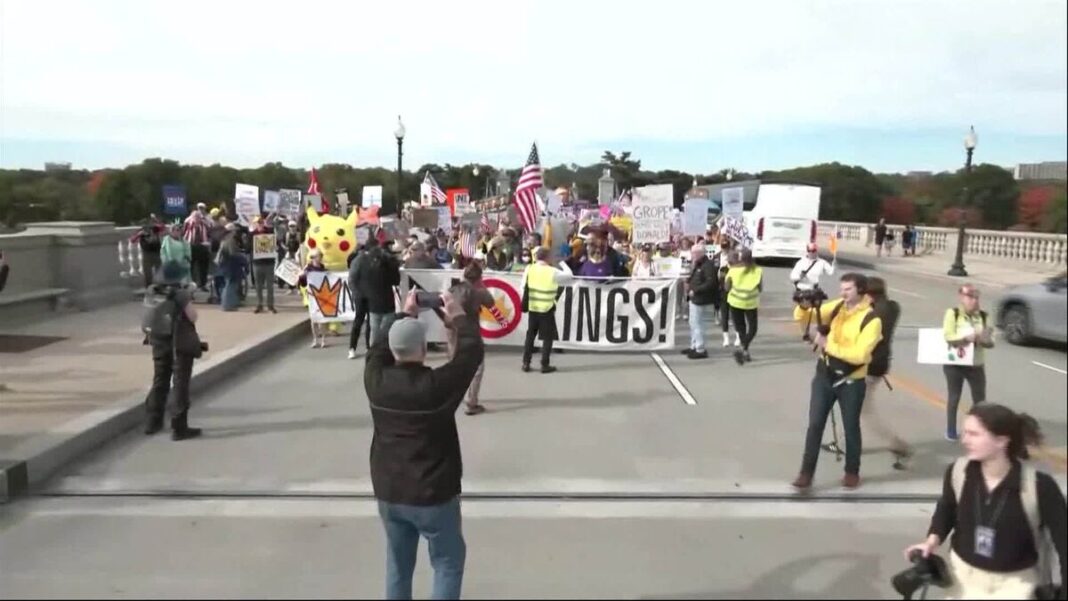Understanding the “No Kings” Protest Against President Trump
In the heart of Washington, D.C., a vibrant display of dissent took place as protesters gathered under the banner of the “No Kings” movement. This gathering was a powerful demonstration against the policies and practices of President Donald Trump. The protest was not merely a collection of individuals with differing opinions; it was a rallying cry reflecting widespread frustrations and calls for change within American governance.
The Symbolism of “No Kings”
The phrase “No Kings” carries significant weight in the context of American democracy. Rooted in the country’s foundational ethos, it evokes the rejection of monarchy and the belief in egalitarian governance. Protesters embraced this slogan as a means of expressing their discontent not just with President Trump’s leadership style, but also with his administration’s policies on issues such as immigration, healthcare, and civil rights.
By declaring a stance against “kings,” protesters aimed to highlight a perceived authoritarianism in Trump’s governance. It was a call to return to the principles of democracy, where every voice matters and power is held responsibly.
Diverse Voices of Protest
The “No Kings” protest was marked by a diverse array of participants. Individuals from various backgrounds came together, unified by a shared goal—challenging the status quo. Students, activists, and community members carried signs bearing slogans that articulated their concerns and hopes for the future. This coalition showcased the wide-ranging impact of Trump’s policies across different demographics, emphasizing that the fight for equality and justice is far from over.
Speakers at the event shared personal stories, illuminating how specific policies had affected their lives and communities. Their narratives underscored the necessity of activism and the importance of standing up for one’s beliefs in the face of oppression.
The Role of Art and Expression
Art played a pivotal role during the protest, creating an atmosphere that was both powerful and poignant. Murals, banners, and artistic performances filled the streets, transforming the protest into a vibrant tapestry of expression. Artists used their talents to communicate messages that resonated deeply with attendees, sparking conversations and reflections on the state of the nation.
This artistic element was not merely for decoration; it served a functional purpose in mobilizing attention to the issues at hand. Art has always been a catalyst for social change, and at the “No Kings” protest, it proved to be an essential tool for inspiring solidarity and fostering dialogue.
Media Coverage and Public Reaction
The protest received considerable media attention, highlighting the significance of public demonstrations in a democratic society. Journalists and media outlets flocked to cover the event, photographing passionate participants and documenting the key themes that emerged throughout the day.
Public reactions varied, with some supporting the movement’s message while others criticized the protesters as being disruptive. This dichotomy reflects the ongoing divisions within American society regarding political discourse and protest culture. Supporters highlighted the necessity of voicing dissent in the name of progress, while critics often viewed the protest as counterproductive.
The Legacy of Protest in American History
The “No Kings” protest draws parallels to historic movements in America’s past where collective action led to significant social and political changes. From civil rights marches to anti-war demonstrations, protests have long been a vital element of American democracy. The legacy of standing up against injustice is woven into the nation’s fabric, reminding citizens that their voices matter and that change is achievable when people unite.
In this context, the “No Kings” movement can be seen as a continuation of that tradition, driven by a commitment to hold leaders accountable and push for policies that reflect the people’s will. It serves as a reminder that activism is not just a phase but an ongoing responsibility for citizens who value democracy.
Activism Beyond the Protest
The spirit of the “No Kings” protest extends beyond a single day. Many participants viewed the event as a launching pad for ongoing activism aimed at creating systemic change. Workshops, community meetings, and voter registration drives emerged in the wake of the protest, underscoring a commitment to long-term engagement.
This grassroots mobilization showcases how protests can inspire sustained action and community building. It reflects a growing awareness that, while protests are powerful, they must be complemented by continual efforts to engage with the political process, influence policies, and mobilize others into action.
Conclusion
The “No Kings” protest in Washington, D.C. was more than just a collection of voices raised in opposition; it represented a moment of solidarity, creativity, and hope in the fight for democratic ideals. The multi-faceted approaches to expression, diversity of participants, and the emphasis on ongoing activism illustrate the vital role that protests play in shaping public discourse and driving societal change. The movement reflects an enduring commitment to ensuring that the voices of all citizens remain at the forefront of America’s democratic journey.



